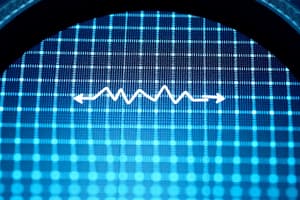Podcast
Questions and Answers
What is the unit of measurement for electric charge?
What is the unit of measurement for electric charge?
- Volt (V)
- Ohm (Ω)
- Ampere (A)
- Coulomb (C) (correct)
What is the formula to calculate electric charge?
What is the formula to calculate electric charge?
- q = e ^ n
- q = n * e (correct)
- q = e / n
- q = n / e
What is the charge of a single electron?
What is the charge of a single electron?
- -1.602 × 10^-19 C (correct)
- 1.602 × 10^-19 C
- 1.6 × 10^-19 C
- 6.24150962915265 × 10^18 C
What is the law that states that electric charge can be moved but not created or destroyed?
What is the law that states that electric charge can be moved but not created or destroyed?
What type of circuit element provides a specified voltage or current that is completely independent of other circuit variables?
What type of circuit element provides a specified voltage or current that is completely independent of other circuit variables?
What is the purpose of the resistor colour code table?
What is the purpose of the resistor colour code table?
What is the formula to calculate the minimum value of a resistor with a tolerance of 20%?
What is the formula to calculate the minimum value of a resistor with a tolerance of 20%?
What is the name of the law that relates voltage, current, and resistance in a circuit?
What is the name of the law that relates voltage, current, and resistance in a circuit?
What is the primary objective of the circuit theory course?
What is the primary objective of the circuit theory course?
What is an electric circuit?
What is an electric circuit?
What is the name of the lecturer for the course ENEE 122?
What is the name of the lecturer for the course ENEE 122?
What is the venue for the course ENEE 122?
What is the venue for the course ENEE 122?
What is the name of one of the recommended books for the course ENEE 122?
What is the name of one of the recommended books for the course ENEE 122?
What is the primary function of a fuse in an electric circuit?
What is the primary function of a fuse in an electric circuit?
What is the term for the collection of circuit elements and wires?
What is the term for the collection of circuit elements and wires?
What is the term for all components that make the transfer of charge in an electrical circuit possible?
What is the term for all components that make the transfer of charge in an electrical circuit possible?
What is the formula for total resistance in series?
What is the formula for total resistance in series?
What is the formula for total capacitance in parallel?
What is the formula for total capacitance in parallel?
What is the formula for total inductance in series?
What is the formula for total inductance in series?
What is a node in a circuit?
What is a node in a circuit?
What is the foundation of circuit analysis?
What is the foundation of circuit analysis?
What is Kirchhoff's Voltage Law?
What is Kirchhoff's Voltage Law?
What is a branch in a circuit?
What is a branch in a circuit?
How can Kirchhoff's Laws be applied to Network solution?
How can Kirchhoff's Laws be applied to Network solution?
Flashcards are hidden until you start studying
Study Notes
Course Overview
- The course introduces basic concepts of network and circuit analysis, providing a solid theoretical and practical foundation for future courses in engineering programs.
Electric Quantities
- Electric charge is a property of matter, measured in SI units called "Coulomb (C)".
- 1 Coulomb is the total charge of 6.24150962915265×1018 electrons.
- Electric charge can be moved but not created or destroyed (Law of Conservation of Charge).
Circuit Elements
- Ideal Independent Source: provides a specified voltage or current, independent of other circuit variables.
- Ideal Independent Voltage Source: provides a specified voltage.
- Ideal Independent Current Source: provides a specified current.
- Ideal Dependent Voltage Source: depends on other circuit variables.
Resistance
- Resistance values exist within certain tolerance limits.
- Tolerance is the maximum difference between the actual value and the required value, expressed as a plus or minus percentage value.
Ohm's Law
- Relates voltage, current, and resistance in a circuit.
- Derived units from Ohm's Law can be calculated.
Resistors
- Resistors in series: RT = R1 + R2.
- Resistors in parallel: 1/RT = 1/R1 + 1/R2.
- Resistor colour code table: used to identify resistor values.
Capacitance and Inductance
- Capacitors in parallel: CT = C1 + C2 + C3 + … + CN.
- Capacitors in series: 1/CT = 1/C1 + 1/C2 + … + 1/CN.
- Inductors in series: LT = L1 + L2 + L3 + … + LN.
- Inductors in parallel: 1/LT = 1/L1 + 1/L2 + … + 1/LN.
Network Basics
- Branch: a single two-terminal element in a circuit.
- Node: the point of connection between two or more branches.
- Loop: any closed path in a circuit.
Kirchhoff's Laws
- Kirchhoff's Current Law (KCL): the sum of currents entering a node is equal to the sum of currents leaving a node.
- Kirchhoff's Voltage Law (KVL): the sum of voltage changes around a loop is zero.
- Kirchhoff's laws relate voltages and currents in different branches.
Studying That Suits You
Use AI to generate personalized quizzes and flashcards to suit your learning preferences.




